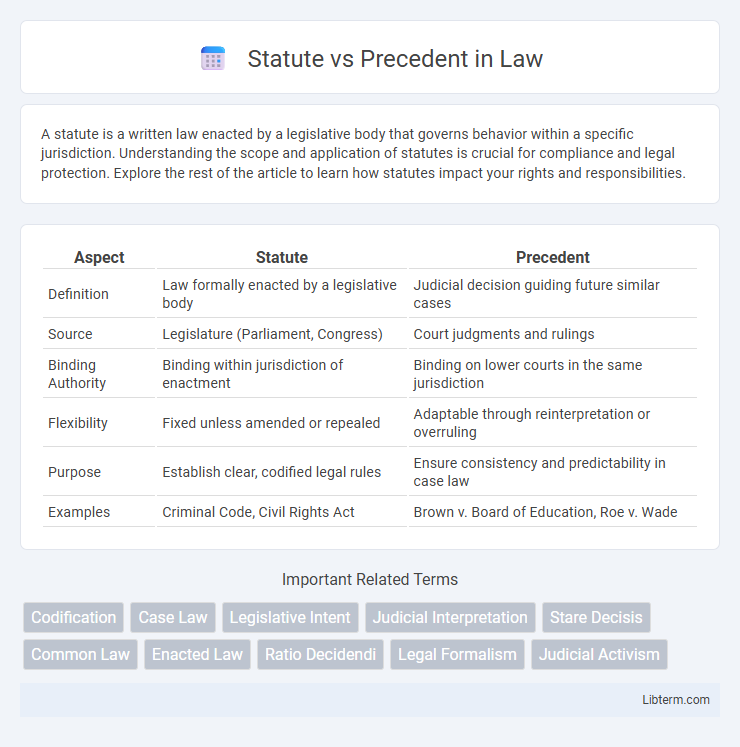A statute is a written law enacted by a legislative body that governs behavior within a specific jurisdiction. Understanding the scope and application of statutes is crucial for compliance and legal protection. Explore the rest of the article to learn how statutes impact your rights and responsibilities.
Table of Comparison
| Aspect | Statute | Precedent |
|---|---|---|
| Definition | Law formally enacted by a legislative body | Judicial decision guiding future similar cases |
| Source | Legislature (Parliament, Congress) | Court judgments and rulings |
| Binding Authority | Binding within jurisdiction of enactment | Binding on lower courts in the same jurisdiction |
| Flexibility | Fixed unless amended or repealed | Adaptable through reinterpretation or overruling |
| Purpose | Establish clear, codified legal rules | Ensure consistency and predictability in case law |
| Examples | Criminal Code, Civil Rights Act | Brown v. Board of Education, Roe v. Wade |
Introduction to Statute and Precedent
Statutes are formal written laws enacted by legislative bodies, providing clear, codified rules applicable to specific jurisdictions and situations. Precedents consist of prior judicial decisions that guide courts in interpreting laws and resolving similar cases, ensuring consistency and predictability in legal outcomes. While statutes represent authoritative legislative mandates, precedents embody the judiciary's role in shaping law through case-by-case interpretation.
Definition of Statute
A statute is a formal written law enacted by a legislative body, establishing legal standards and obligations. It provides clear, codified rules that govern specific areas of law and must be followed by courts and individuals. Unlike precedent, which is based on judicial interpretations from previous cases, statutes serve as primary sources of law with direct legislative authority.
Definition of Precedent
Precedent refers to a judicial decision or legal case that serves as an authoritative rule or pattern in future similar or analogous cases. It is a principle established by a higher court's ruling that lower courts are obligated to follow to ensure consistency and predictability in the law. Unlike statutes, which are written laws enacted by legislative bodies, precedents evolve through judicial interpretation and application over time.
Sources of Statute and Precedent
Statutes originate from legislative bodies such as parliaments or congresses, reflecting codified laws that provide clear, written rules applicable to specific jurisdictions. Precedents are derived from judicial decisions, where courts interpret statutes or legal principles through case law, establishing binding or persuasive rules for future cases. Both sources interact closely, with statutes offering formal law and precedents ensuring its practical application and evolution within the judicial system.
Hierarchy and Authority in Law
Statutes hold primary authority in the legal hierarchy as they are enacted laws passed by legislative bodies, embodying explicit legal rules and mandates. Precedents, derived from judicial decisions, function as binding or persuasive authority depending on the court's position within the hierarchy and the principle of stare decisis. Higher courts' precedents hold greater authority, but statutes prevail when conflicts arise between legislative codes and judicial interpretations.
Application in Legal Proceedings
Statutes serve as written laws enacted by legislative bodies, providing clear, codified rules that courts apply directly to cases. Precedents consist of prior judicial decisions that guide judges in interpreting statutes and resolving similar legal issues when statutes are ambiguous or silent. In legal proceedings, courts prioritize statutes but rely on precedents to ensure consistency and adapt the law to evolving circumstances.
Advantages of Statute
Statutes provide clear, codified laws that ensure consistency and predictability in legal interpretation, reducing ambiguity compared to case-by-case judicial decisions. They enable legislatures to address specific issues comprehensively and democratically, reflecting societal values and policy goals. Statutes also allow for easier updates and reforms through legislative processes, maintaining legal relevance over time.
Advantages of Precedent
Precedent offers the advantage of consistency by ensuring similar cases receive similar judgments, promoting fairness and predictability in the legal system. It allows courts to adapt legal principles to evolving societal values and new situations without waiting for legislative changes. Furthermore, the use of precedent saves time and resources by providing established legal frameworks that guide judicial decision-making efficiently.
Key Differences Between Statute and Precedent
Statutes are written laws enacted by legislative bodies, providing clear, codified rules applicable in various legal situations, while precedents are judicial decisions made by courts that guide future cases through the principle of stare decisis. Unlike statutes, precedents evolve over time as courts interpret laws in different contexts, offering flexibility and adaptability in common law systems. The binding nature of statutes is generally absolute unless amended or repealed, whereas precedents hold persuasive or binding authority depending on the court hierarchy and jurisdiction.
Conclusion: Impact on Legal System
Statutes create clear, codified laws that provide consistency and predictability within the legal system, ensuring uniform application across jurisdictions. Precedents shape judicial interpretation through past rulings, allowing flexibility and adaptation to evolving societal values. Together, statutes and precedents balance rigidity and discretion, profoundly influencing the development and stability of the rule of law.
Statute Infographic

 libterm.com
libterm.com